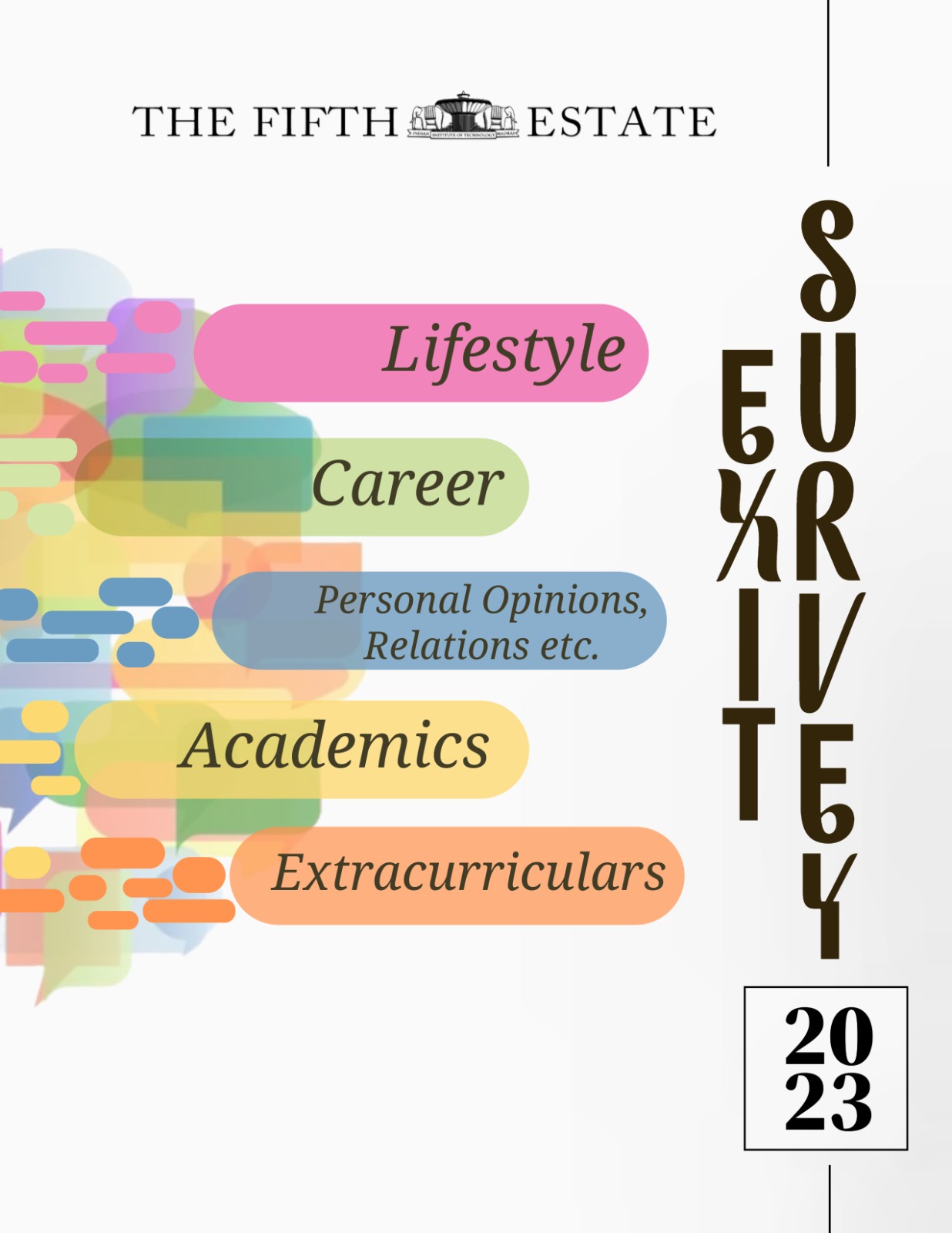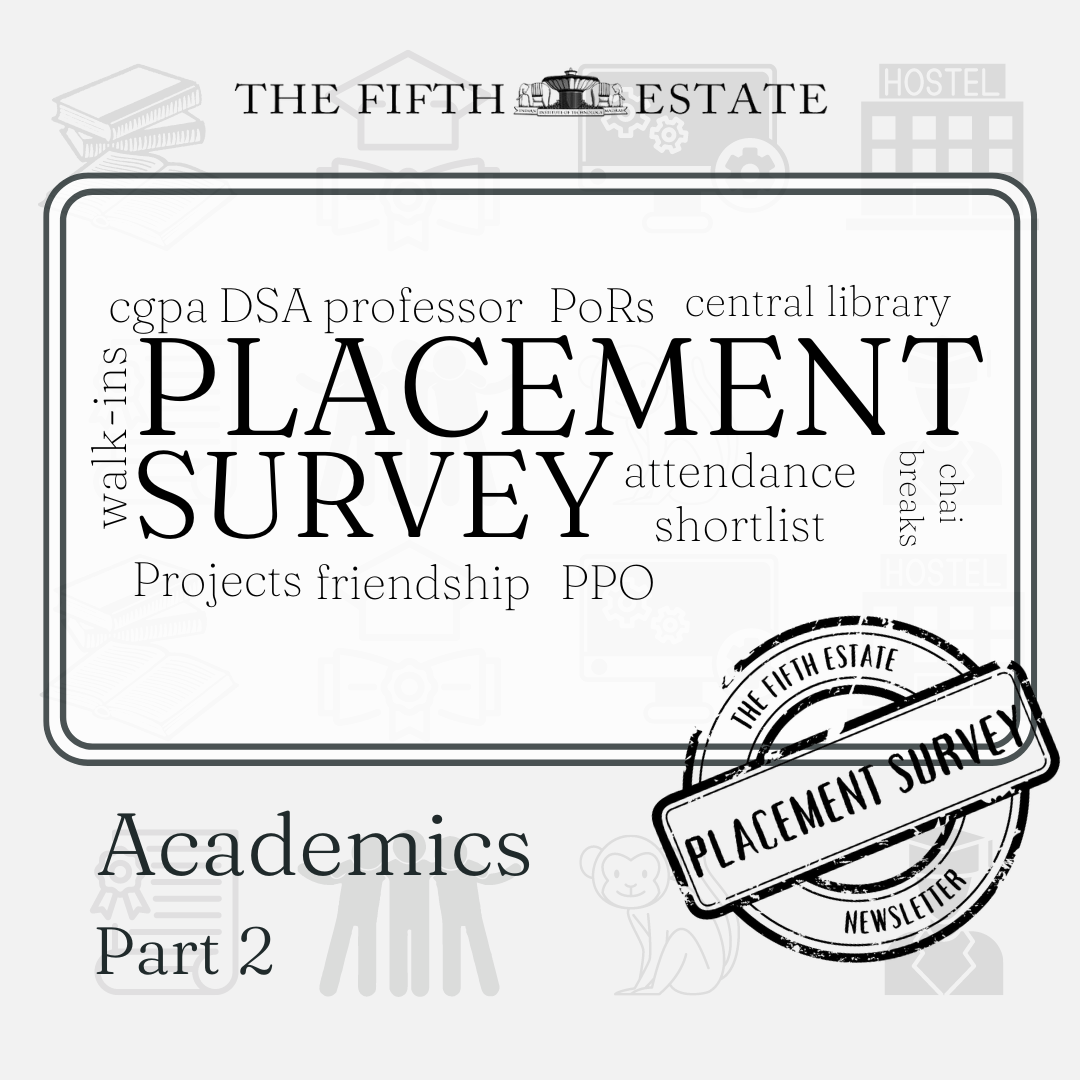In the last semester, T5E conducted its annual Exit Survey 2023 to analyze graduating student’s perspectives of life at IIT Madras. The survey had 141 responses across the entire graduating class of 2023, nearly 60% of the survey respondents being UG students (B.Tech + DD+ MA) while the rest were PG students (MSc + MTech + MBA + PhD + MS). The poll looked into a variety of elements that make up an insti student, including their academics, extracurriculars, career & decision-making skills, lifestyle and opinions. This article is a comprehensive report covering a series of segments. Each segment comprises a graphical representation of some of the most popular insights followed by a general summary.
ACADEMICS
Satisfaction with CGPA
According to the poll results, 53.49% of students were happy with their current Cumulative Grade (CG). A sizable 34.88% of respondents showed some degree of contentment, albeit with some reservations. On the other hand, 11% of respondents said they would eagerly welcome the chance to raise their CG. These results highlight the conflicting opinions students have about their academic performance. While a sizeable portion is content, a noticeable group also has desires to do better in school. It implies the significance of academic support structures and plans to meet the various requirements and goals of students in their quest for academic achievement.
Branch change
14% of respondents moved branches, while the bulk of 85% remained the same. When questioned about their preferred branch conversion, 44% of students strongly desired to convert to computer science, demonstrating the field’s enormous popularity and demand. Electrical engineering was the second most wanted choice, with which 27% of the students sided. Chemical and mechanical engineering were the third most popular choices, with 10% of students preferring each of the fields. This overwhelming choice for computer science indicates a significant trend, demonstrating the field’s great attraction and perceived potential. These findings provide vital insights into students’ academic objectives and interests, underscoring the importance of computer science as a field of study.
General insights:
A significant portion of students opted out of placement exams, preferring to pursue further education or non-core job opportunities, with a notable interest in entrepreneurship and government positions.Career paths were often decided in the penultimate year, although indecision persisted for some even during placement season. Study habits ranged widely, with a considerable number of students investing minimal time in daily study, while others exhibited more rigorous academic discipline. Preferences for study environments were split between the library for solitary focus and group study with peers. Balancing academics with other interests proved challenging for many, with nearly half feeling constrained by their academic load. Contentment with CGPA was mixed, with a majority satisfied but a noticeable portion striving for improvement. The utility of one’s branch in aiding post-graduation goals was also a point of contention, with opinions varying from highly beneficial to unhelpful. Approaches to studying for exams were predominantly last-minute or underprepared, with a smaller fraction adhering to regular study and revision. Finally, the facilities for project work were deemed inadequate by a significant number of students, highlighting a need for improved resources and opportunities for project collaboration with faculty.
EXTRACURRICULARS AND MENTAL HEALH
Impact of Saathi / MiTr / Your DOST / Insti Counsellors
Only about 10% of the respondents reported having had a positive influence from their respective mentors/counsellors. Whereas around 21% reported either not being satisfied with the guidance or avoiding it due to the stigmas around. Surprisingly, around 67% of the respondents claim to have not requiring any professional help during their insti years.
Insti Life Experience checklist
Looks like it would be difficult to find someone who wasn’t attacked by a monkey or spent an entire night sleepless in insti- After all, monkeys and insomnia define insti, don’t they?
Which of these groups were you part of?
Saarang, Shaastra, and CFI seemed to be the three most popular choices among respondents, with an average of around 49% students being part of either of these teams. This is followed by Insti Contingent Team (Sports,Tech, Culturals), Saathi, Department Fests, and Placement & Internship Teams. There are also around 27% of students who chose not to be a apart of any of these groups during their insti years.
General insights:
This segment of the explored that only a minority of students reported positive influences from their Saathi/Mitr mentors, and the overall institutional experience received a modest rating.The study also explored students’ involvement in extracurricular activities, showing preferences for certain groups and indicating that most students’ academic performance was unaffected by their positions of responsibility. Students expressed varied levels of enthusiasm for different events and discussed the developmental benefits of participation in extracurricular activities. Additionally, it revealed the relationship between academic performance and participation in certain groups. Lastly, students reflected on what they would do differently if given a second chance to start their institutional journey, emphasizing a desire for a more active, focused, and social experience.
LIFESTYLE
Bath and Sleep routines
A majority of the respondents (around 68%) claimed of taking bath at least once a day. This percentage is similar to that of last year. Whereas 25% of the respondents took bath only for a few days a week. The remaining 7%, comprising a small proportion of the respondents admitted that compromised due to time scarcity or went without bathing for weeks. Coming to sleep schedules, the results showed similar trends from last year. There were about 48% of students who slept around 1-3 AM making it the most common time of going to bed.
How many days per week could you take out time for sports and fitness?
Fortunately, a majority of 44% respondents could manage to take out 3+ days a week for sports and fitness. 28% could devote less time (1 or 2 days) and the remaining 28% couldn’t devote time to sports and fitness.
General insights:
This survey delves into the daily habits and routines of students during their time at insti. The majority of respondents maintained a daily bathing routine, with only a fraction opting for a less frequent approach. When it came to breakfast, a substantial portion of students frequently skipped it, while others were more consistent in their morning meals. Sleep patterns revealed that bedtime around 1-3 AM was the most common, consistent with previous years’ findings. In terms of sports and fitness, a significant number of students managed to allocate at least three days a week for physical activities. Language proficiency was a mixed factor in forming friendships and joining groups, with some students preferring those who shared their native language while others embraced the linguistic diversity.
CAREER AND DECISION MAKING
Career Path Ahead
Approximately 43% of the participants opted for a non-core sector job, slightly surpassing the previous year’s figure of 40% recorded in the 2022 exit survey. Meanwhile, 26% selected a core sector job, and 23% decided on higher studies within the core sector, encompassing MS, MBA, PhD, Postdoc, etc. The percentage of people taking a break has also decreased from the year before, potentially attributed to the pandemic slowly receding.
Current career trajectory vs exploring alternative career paths
63% of respondents want to stick to their career path for at least 2 years, but 30% are still unsure if they want to continue for 2 years and want to see how things will go on their chosen path. Meanwhile, around 8% of respondents want to change their career path in two years or earlier. Around 59% of the respondents who got a job in Non-core were sure about their career path in the future, whereas the number rose to 61% for core aspirants who got a job in the core and are sure about sticking to their path for 2 years. This might mean that people are quite satisfied with the roles offered to them, indicating a preference for continuity rather than job switching. Similarly, people who have chosen to pursue higher studies, whether in core or non-core, seem to be quite confident in their choices.
General insights:
The survey reveals a notable shift towards non-core jobs continues, with many graduates also expressing interest in higher studies. Job satisfaction shows variation, with a significant portion of students feeling they could have secured better opportunities, particularly among PhD candidates. It highlights the influence of peers and faculty on career decisions, the importance of clarity in career paths during the latter stages of education, and a general trend towards maintaining chosen career paths post-graduation. Despite the pandemic’s disruptions, its impact on career choices appears to be waning. The pursuit of higher education remains strong, and participation in hackathons and competitions correlates with job placement satisfaction. Overall, the survey sheds light on the complex interplay of factors guiding the career decisions of young professionals as they step into the future.
PERSONAL, OPINIONS AND RELATIONSHIPS
Nature and Behavior
We see that over 30% of students who participated in the survey identified themselves to be introverted. About 50% of the students considered themselves ambiverts.
Has that Changed since coming to Insti?
We saw that a lot of people (~65%) had tried moving out of their comfort zones by trying to change some of their social interaction patterns in insti.
How many relationships were you in?
Dating in insti seems to garner very mixed reactions! Of all the respondents, about 64% reported never having been in a relationship. But the fact that approximately 35% of respondents had been in a relationship during their time here – either with someone from Insti or with someone outside – pointed towards the presence of some romance on campus.
Interaction with the opposite Sex
When asked about their interactions with the opposite sex, it was found that around 42% of the respondents had close friends of genders other than their own. About 38% of students had interacted with the opposite sex and preferred to refer to them as their acquaintances.
Relationships vs friend circles
When we took a look at the relationships of people with respect to their interactions with the opposite sex, we saw that people who had more friends of other genders were more likely to have been in a relationship in Insti as compared to those who did not interact much with the students of other genders.
General Insights:
This survey revealed that a significant portion of students identified as introverted or ambiverted, with many actively attempting to expand their social interactions during their time at the institution. It also delved into students’ dating experiences, revealing a presence of romantic relationships on campus and insights into how students cope with relationship endings. Interaction with the opposite sex and friend circles had a notable correlation with relationship status.
What is the one unforgettable thing about Insti?
“The campus, people and the freedom :)”
“Late night walks, friends and life lessons”
“Caught by guards for climbing water tank”
“The randomness and uncertainty in everything – from outings to meeting people”
“Late night ganga canteen bytes”
“The professors and research scholars were some of the amazing people I ever came across.”
What is one thing that you will not cherish about insti?
“Monkeys, Weather, Mess Food and 8 AM classes”
“Trauma from failed relationship, exams and rejections”
“Not able to explore more”
“The pressure during intern and placement season”
“Peer and academic pressure”
“The obsession with grades and its hindrance to real learning”
Compiled by: Medhaa and Arun
Edited by: Aditi Rathore, Ankita Murthy, Ashita Anil, Garima Sane and Pooja Shankar
Design by: Aditi Das




